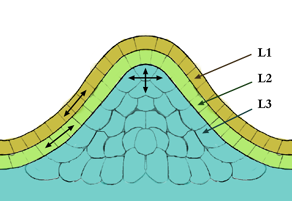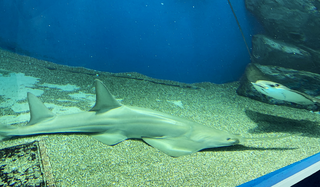Related Research Articles

The meristem is a type of tissue found in plants. It consists of undifferentiated cells capable of cell division. Cells in the meristem can develop into all the other tissues and organs that occur in plants. These cells continue to divide until a time when they get differentiated and then lose the ability to divide.

Paraponera clavata is a species of ant, commonly known as the bullet ant, named for its extremely painful sting. It inhabits humid lowland rainforests in Central and South America.

Trichonephila clavata, also known as the Jorō spider, is a member of the golden orb-web spider genus. The spider can be found throughout Japan, in Korea, Taiwan, China, and more recently, northeast Georgia and western South Carolina in North America. Due to its large size and the bright, unique colors of the female Trichonephila, the spider is well-favored in Japan.
Poneratoxin is a paralyzing neurotoxic peptide made by the bullet ant Paraponera clavata. It prevents inactivation of voltage gated sodium channels and therefore blocks the synaptic transmission in the central nervous system. Specifically, poneratoxin acts on voltage gated sodium channels in skeletal muscle fibers, causing paralysis, and nociceptive fibers, causing pain. It is rated as a 4 plus on the Schmidt sting pain index, the highest possible rating with that system, and its effects can cause waves of pain up to twelve hours after a single sting. Schmidt describes it as "pure, intense, brilliant pain...like walking over flaming charcoal with a three-inch nail embedded in your heel." It is additionally being studied for its uses in biological insecticides.

The dwarf sawfish or Queensland sawfish, Pristis clavata, is a sawfish of the family Pristidae, found in tropical Australia. This endangered species is the smallest species in its family.

The thornback ray, or thornback skate, is a species of ray fish in the family Rajidae.

Hakea clavata, commonly known as coastal hakea is a shrub that is endemic to an area along the south coast of Western Australia. It has thick leaves, pink and grey flowers and grows on rocky outcrops.
Scopula hesycha is a moth of the family Geometridae. It is found in Central China.

Paraponera is a genus of ants and the only genus in the subfamily Paraponerinae. The name means "near-Ponera".

Onciderini is a tribe of longhorn beetles of the subfamily Lamiinae, they are prevalent across Europe in nations such as Turkey, and Finland.

Paramuricea clavata, the violescent sea-whip, is a species of colonial soft coral in the family Plexauridae. It is found in shallow seas of the north-eastern Atlantic Ocean and the north-western Mediterranean Sea as well as Ionian Sea. This species was first described by the French naturalist Antoine Risso in 1826.
Hesycha is a genus of longhorn beetles of the subfamily Lamiinae, containing the following species:
Hesycha bimaculata is a species of beetle in the family Cerambycidae. It was described by Martins and Galileo in 1990. It is known from Brazil.
Hesycha fasciata is a species of beetle in the family Cerambycidae. It was described by Martins and Galileo in 1990. It is known from Brazil.
Hesycha microphthalma is a species of beetle in the family Cerambycidae. It was described by Martins and Galileo in 1990. It is known from Brazil.
Hesycha cribripennis is a species of beetle in the family Cerambycidae. It was described by Léon Fairmaire and Germain in 1859. It is known from Chile.
Hesycha crucifera is a species of beetle in the family Cerambycidae. It was described by Dillon and Dillon in 1952. It is known from Brazil.
Hesycha variabilis is a species of beetle in the family Cerambycidae. It was described by Dillon and Dillon in 1945. It is known from Argentina, Brazil and Paraguay.
Petrophile clavata is a species of flowering plant in the family Proteaceae and is endemic to southwestern Western Australia. It is a shrub with curved, needle-shaped, sharply-pointed leaves and spherical heads of hairy, cream-coloured to very pale yellow flowers.
References
- ↑ BioLib.cz - Hesycha clavata. Retrieved on 8 September 2014.